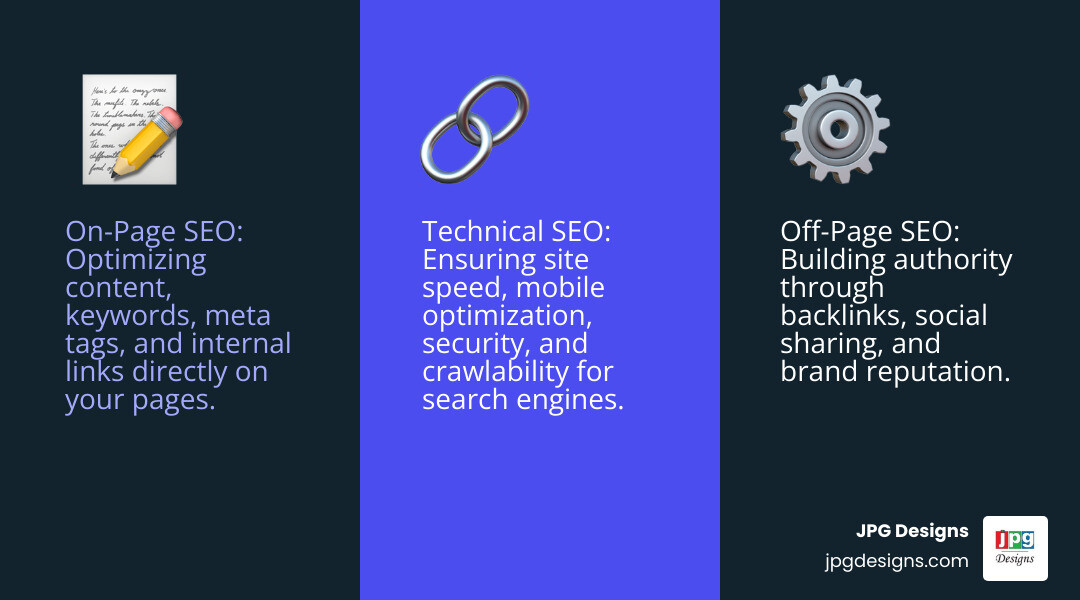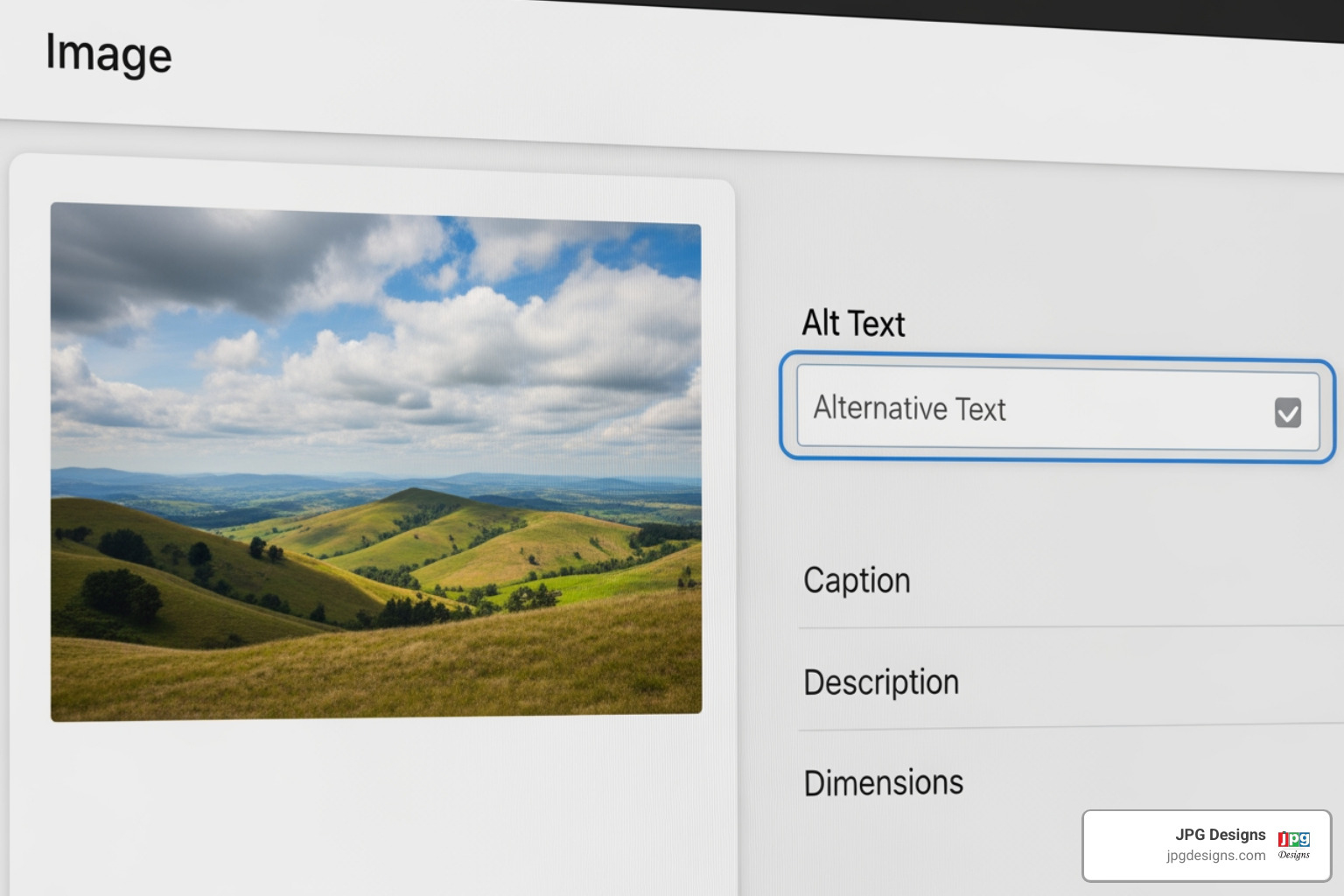What is SEO and Why Does It Matter for Your Business?
How to SEO optimize your website is a critical question for any modern business. Search Engine Optimization (SEO) is the process of improving your website so search engines like Google can better understand it and show it to people searching for what you offer. Good SEO helps you rank higher in search results, meaning more people find your business without you paying for ads.
Here’s how to SEO optimize your website in six steps:
- Start with keyword research – Find the words and phrases your customers use.
- Create high-quality content – Write helpful, original content that answers user questions.
- Optimize on-page elements – Fix your titles, descriptions, URLs, and internal links.
- Build a strong technical foundation – Ensure your site is fast, secure, and mobile-friendly.
- Promote your content – Earn links and shares from other trusted websites.
- Track and maintain your progress – Monitor your rankings and traffic, and make regular updates.
Around 64% of organic traffic comes from search, while only 10% comes from social media. This is why SEO matters. Ranking on the first page of Google builds instant credibility and reaches customers at every stage of their buying journey.
SEO works because search engines want to show the best, most relevant, and trustworthy results. Your goal is to prove that your website checks all those boxes. The challenge is that SEO involves hundreds of factors, from keywords and page speed to mobile experience and content quality. This guide breaks down the essential steps to get you started.
I’m Jeff Pratt, owner of JPG Designs, and I’ve spent over 15 years helping businesses in Rhode Island and beyond use SEO to drive real revenue growth. Let’s dive in.

Step 1: Building Your Strategy with Keyword Research
Keyword research is about learning your customer’s language. Before you create content, you must understand what people are typing into Google to find businesses like yours. These words and phrases are your keywords.
The power of keyword research lies in understanding search intent. Is someone looking to learn, compare, or buy? Matching your content to their intent is crucial.
- Short-tail keywords (e.g., “SEO”) are broad, competitive, and get many searches.
- Long-tail keywords (e.g., “how to SEO optimize my small business website”) are specific, less competitive, and attract qualified visitors.
When evaluating keywords, search volume (how many searches per month) and keyword difficulty (how hard it is to rank) help you find the sweet spot. A smart approach is to organize content into topic clusters: a main pillar page covering a broad topic, supported by related pages that dive deeper. This structure signals your authority to search engines.
For more on this, see our guide on 7 Tips to Get the Best On-Page SEO Results.
You can start with free tools like Google Keyword Planner, Google Trends, and Answer the Public to find keywords and understand user questions.
Understanding Your Audience’s Search Language
Start with seed keywords—the basic terms for what you do (e.g., “web design,” “digital marketing”). Then, brainstorm all the questions your customers ask. This leads to question-based keywords like “how do I get my website on Google?” which are perfect for content ideas.
Understanding the difference between commercial and informational keywords is key. “How to fix a leaky faucet” is informational. “Emergency plumber Providence RI” is commercial. Your content must match this intent. Create helpful guides for informational searches and showcase your services for commercial ones. Winning at SEO means understanding your customer’s search language and creating content that meets them at each stage of their journey.
Step 2: Creating High-Quality, Authoritative Content
Once you know what your audience is searching for, it’s time to create content that genuinely helps them. The old saying still holds true: Content is King. No amount of technical tweaking can save thin, unhelpful content.
Google’s goal is to show the best answer. This means your content must demonstrate Experience, Expertise, Authoritativeness, and Trustworthiness (E-E-A-T). When someone lands on your page, they should feel they’re learning from a true expert.
Quality always beats quantity. One comprehensive, helpful article will outperform ten shallow ones. While fresh content matters, it’s more important to keep your existing content current. Update old posts with new information and statistics to show search engines you’re maintaining your resources.
Avoid keyword stuffing—the outdated practice of cramming keywords into your text. Modern search engines understand context and natural language. Write for humans first, and keywords will follow naturally.
For a deeper dive, see our guide on Content is King: Creating High-Quality SEO Optimized Content and Google’s own guide on creating helpful, reliable, people-first content.
How to SEO Optimize Your Content for Readers and Search Engines

At JPG Designs, we write for people first. If humans find your content confusing or boring, search engine rankings won’t matter.
Content structure is critical for both SEO and readability. Use one H1 heading for your main title. Use H2 headings for major sections and H3s for subsections. This creates a logical hierarchy that’s easy for readers and search engines to follow.
Use short paragraphs, bold text for key points, and lists to make your content scannable. Dense blocks of text are overwhelming, especially on mobile devices.
Regarding content length, depth matters more than word count. Research shows top-ranking pages are often comprehensive (around 1,447 words), but the goal isn’t to hit a number. It’s to completely answer the user’s question. If you can do that in 800 words, great. If it takes 2,500, that’s fine too. Ask yourself: have I covered this topic thoroughly and clearly?
For a more advanced look, check out our guide on how to Optimize Website Semantic Search. The bottom line is to focus on readability, clear structure, and comprehensive coverage. Do this consistently, and rankings will follow.
Step 3: Mastering On-Page SEO Optimization
After creating valuable content, you need to polish the technical details that help search engines understand it. This is on-page SEO, and it’s full of easy wins.
When you how to SEO optimize these elements, you’re giving Google a clear roadmap to your content.
- Meta Title: The clickable headline in search results (under 60 characters). It’s your first impression. Include your primary keyword and make it compelling. Google may rewrite it, but a well-crafted title still heavily influences what appears.
- Meta Description: The text below the title (about 155-165 characters). It doesn’t directly affect rankings, but it convinces people to click. Include your keyword and a benefit.
- URL Structure: A clean URL like
jpgdesigns.com/how-to-seo-optimizetells users and search engines what to expect. Use hyphens and include your primary keyword. - Internal Linking: Linking to related pages on your own site helps visitors find more content and shows Google how your pages are connected. Use descriptive anchor text that tells readers what they’ll find when they click.
For a complete breakdown, our article on SEO Elements: Website Design and Optimization covers everything in detail.
How to SEO Optimize Images for Better Visibility
Images make content engaging and offer another chance to how to SEO optimize your pages.

- File Names: Before uploading, rename files descriptively (e.g.,
web-design-providence-office.jpginstead ofIMG_001.jpg). - Alt Text: This description helps visually impaired users and tells search engines what an image depicts. A descriptive alt text including your keyword can drive traffic from image searches. Learn more about alt text best practices from Siteimprove.
- Image Compression: Large images slow down your site, which hurts SEO. Compress images to reduce file size without sacrificing quality.
- File Types: Use JPEGs for photos, PNGs for graphics with transparency, and WebP for a modern balance of quality and compression.
Implementing Local SEO for Physical Businesses
If you serve customers in specific locations like Warwick RI or Cranston RI, local SEO is a game-changer. It helps you appear when someone searches “web designer near me.”
- Google Business Profile: This free tool is the cornerstone of local SEO, managing how you appear in Google Maps and local results. Optimize it with accurate info, hours, and photos.
- Local Keywords: Weave location-specific terms (e.g., “digital marketing Newport RI”) into your content, titles, and descriptions.
- NAP Consistency: Your business Name, Address, and Phone number must be identical everywhere online. Inconsistencies confuse search engines and can hurt local rankings.
- Online Reviews: Reviews are a significant local ranking factor. Encourage happy clients to leave them on your Google Business Profile and respond to all feedback professionally.
Local SEO drives calls, foot traffic, and customers. Learn more in our article: Why Your Business Can Benefit Greatly From Local SEO.
Step 4: How to SEO Optimize Your Site’s Technical Foundation
Great content is invisible if search engines can’t access your website. Technical SEO is the behind-the-scenes work that makes everything else possible—it’s the foundation of your digital house.

- Site Architecture: A well-organized structure helps users and search engines. A good rule is that any page should be reachable within three clicks from the homepage.
- XML Sitemap & Robots.txt: A sitemap is a roadmap of your important pages for search engines. A robots.txt file tells them which areas to avoid indexing (like admin pages).
- SSL Certificate (HTTPS): This encrypts the connection between your site and visitors. Google uses HTTPS as a ranking signal, and sites without it may be penalized.
- Page Speed: A slow website kills conversions and hurts rankings. Since 2018, Google has used page speed as a ranking factor. We optimize speed through image compression, efficient code, and fast hosting.
At JPG Designs, we handle these technical details so you can focus on your business. Google has been Favoring Mobile-Friendly Websites for years, which leads to our next point.
The Critical Role of Mobile-First Indexing
More people use phones than desktops to browse the web. Mobile-first indexing means Google primarily uses the mobile version of your site for ranking. If your mobile experience is poor, your desktop rankings will suffer.
Responsive design is the solution. A responsive site automatically adapts to any screen size, from a large monitor to a smartphone. But it’s more than just looks. Your mobile site must be fast, with easy-to-tap buttons and readable text.
We build mobile-first websites at JPG Designs, designing for mobile users first and then enhancing for larger screens. This aligns with how Google ranks sites today and sets you up for long-term success. When you how to SEO optimize your technical foundation with mobile-first principles, you’re building for the future.
Dive deeper with our explanation: What is Mobile-First Indexing?
Step 5: Promoting Content and Building Authority
Creating great content is only half the battle; you also have to promote it. This is where off-page SEO comes in, helping you build your reputation across the web.
Off-page SEO includes everything that happens outside your website to influence your rankings. The most important factor is backlinks—links from other websites pointing to yours. Search engines see these as votes of confidence. The more high-quality, relevant backlinks you earn from authoritative sites, the more Google views your website as an authority worth ranking.
How do you earn these links?
- Create link-worthy content: Produce original, authentic resources that people naturally want to share and reference.
- Conduct proactive outreach: Build relationships by suggesting your content as a valuable resource to relevant blogs and publications in your industry.
- Try guest posting: Write an article for another reputable site in your niche to showcase your expertise and earn a natural backlink.
While not a direct ranking factor, social media sharing amplifies your content’s reach. Sharing on platforms like Facebook or LinkedIn increases visibility, driving traffic and creating more opportunities for others to link to your work. As we explore in How Social Media Improves Your SEO, it’s a powerful way to support your SEO efforts.

Different channels work for different audiences. Email newsletters share content with an engaged list, while social media sparks conversation with new audiences. Direct outreach can secure high-quality backlinks. The key is consistency. Building authority takes time, but these efforts compound, strengthening your rankings and growing your organic traffic.
Step 6: Tracking, Analyzing, and Maintaining Your SEO
Learning how to SEO optimize is an ongoing process. It’s more like tending a garden than building a fence—it requires constant nurturing and adjustment.
Fortunately, powerful tools show you exactly what’s working:
- Google Search Console (GSC): This free tool is your direct line to Google. It shows which search terms bring people to your site, reveals crawl errors, and lets you submit your sitemap. It’s essential for monitoring your site’s health.
- Google Analytics (GA): While GSC shows how Google sees your site, GA shows how people use it. You can see which pages are popular, where visitors drop off, and how they steer your site. These insights are gold. Learn more in our guide on Everything You Need to Know About Google Analytics.
- Bing Webmaster Tools: Often overlooked, Bing still captures a meaningful share of searches. Setting this up provides similar insights to GSC for a different audience.
With these tools, we track what matters: keyword rankings and site traffic. We look for trends over weeks and months to understand what’s working. When we see ranking changes, we investigate the cause—was it a content update, a new backlink, or a Google algorithm change? Understanding the “why” informs our strategy.
Regularly updating your content is one of the most important maintenance tasks. Fresh, current information signals to search engines that you are an active authority. At JPG Designs, we treat SEO as an ongoing partnership, constantly monitoring metrics and adapting to keep your business growing.
Frequently Asked Questions about SEO Optimization
How long does it take to see results from SEO?
This is the most common question we get. The truth is, SEO is a long-term strategy. While small tweaks can show results in days, meaningful, sustainable growth takes time. You can typically expect to see a noticeable increase in traffic and impressions within 4-6 months.
The great news is that SEO results compound. The work you do today builds momentum that can bring you traffic for years. Patience and consistency are essential.
Can I do SEO myself?
Yes, DIY SEO is possible, especially for basics like writing good content and optimizing titles. Many free resources like Google Search Console and tutorials can help you get started.
However, SEO has a steep learning curve. For advanced SEO—like technical audits, complex link-building, and adapting to algorithm changes—hiring an expert can save you time and deliver better results. At JPG Designs, we work with businesses at all levels, whether you need a solid foundation to manage yourself or a team to handle everything for you.
How does paid advertising (PPC) affect SEO?
PPC and SEO are separate channels; running Google Ads does not directly boost your organic rankings. Google has been clear that you can’t pay for better organic placement.
However, PPC can support your SEO strategy. Paid ads provide immediate data on which keywords convert and which ad copy works best, which can inform your organic content strategy. Seeing your brand in both paid and organic results also builds trust and increases visibility. Many businesses use PPC for immediate leads while building their long-term SEO foundation. Learn more in our guide on Maximizing Your ROI with SEO & Google Ads.
Conclusion: Your Journey to SEO Domination
Now you understand that learning how to SEO optimize your website is a journey, not a destination. The digital world is always changing, which means there are always new opportunities to improve and better serve your audience.
Let’s recap the key steps:
- Start with keyword research to understand customer intent.
- Create high-quality, people-first content that demonstrates E-E-A-T.
- Master on-page elements like titles, URLs, and internal links.
- Build a robust technical foundation with a focus on speed and mobile-first design.
- Actively promote your content to earn valuable backlinks.
- Consistently track, analyze, and maintain your efforts.
These practices are interconnected. Good technical SEO helps your content get found. Backlinks boost your page authority. Tracking tells you what to do next.
At JPG Designs, this is what we do every day for businesses across Rhode Island—from Providence to Warwick and beyond. We combine cutting-edge, mobile-first web design with expert digital marketing to help you get found on Google. We know that rankings are about driving revenue and growth.
The beauty of SEO is that it compounds. The work you put in today builds momentum for tomorrow, making it one of the few marketing channels where your investment grows in value over time. It requires patience and consistency, but the results are worth the effort.
Ready to take your online presence to the next level? Get a comprehensive digital marketing strategy for your business and let’s build something remarkable together.





